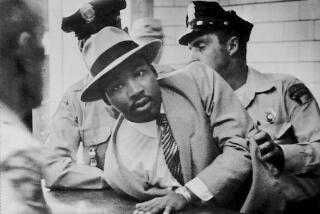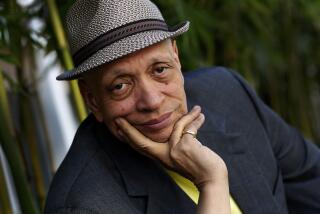The story behind Sir Storyteller
- Share via
DOWN through the centuries, the legend of those bygone days when knighthood was in flower has maintained an enduring hold on the imagination. King Arthur and his Knights of the Round Table have been the subjects of countless poems, stories and novels. Tennyson’s exquisite “Idylls of the King” and William Morris’ powerfully dramatic “The Defence of Guenevere” are among the greatest of the Victorian poetic re-envisionings of the story, while the 20th century gave us T.H. White’s novel “The Once and Future King” and the Lerner and Loewe musical “Camelot,” which inspired the poignant identification of that brief, shining era of chivalry with the all-too-short-lived administration of John F. Kennedy.
Little is known for certain about Arthur, but what’s more surprising is that, in many ways, even less is known about Thomas Malory, the 15th century English knight who combed through the vast collection of elaborate French tales about Arthur and wrote his own far more succinct, direct and realistic version. Completed not long before Malory’s own death in 1471, “Le Morte D’Arthur” proved to be one of the most haunting works of English prose ever penned, the spellbinding beauty of its cadences exercising as deep an appeal as the fascinating story itself.
Among those caught in the spell is Christina Hardyment, who early on in her rather speculative biography “Malory: The Knight Who Became King Arthur’s Chronicler,” directs our attention to the sonorous splendor of the writing in passages like this one:
“More of the death of King Arthur could I never find, but that ladies brought him to his burials; and such one was buried there.... Yet some men say in many parts of England that King Arthur is not dead, but had by the will of our Lord Jesu into another place; and men say that he shall come again.... I will not say it shall be so, but rather I will say: here in this world he changed his life. But many men say that there is written upon his tomb this verse: Hic jacet Arthurus, Rex quondam, Rexque futurus. [Here lies Arthur, the once and future King].”
True or not, the plethora of legends about Arthur makes the once and future king a vivid presence in the mind, whereas it’s hard to formulate a mental image of Thomas Malory and the kind of man he was. Indeed, it wasn’t even clear which Malory was the right one -- there are three Thomas Malorys to choose from -- until Peter Field published the results of his research in his 1993 biography, “The Life and Times of Sir Thomas Malory.”
What records there are of Malory (Sir Thomas Malory of Newbold Revel) do not present a pretty picture. There are a number of legal documents showing that this doughty knight was in and out of prison, charged with a variety of crimes, including treason, rape, robbery, extortion and cattle theft.
From everything that is known about the tenor of those times, it requires no special stretch of imagination to suspect that Malory was the victim of trumped-up charges. It was the age of the War of the Roses, when Lancastrian and Yorkist rivals contended for the kingship, and Malory seems to have been involved -- possibly on both sides -- in this ongoing morass of battles, schemes and betrayals.
But Hardyment is also prepared to indulge in a little myth-making of her own. As she explains at the outset: “My book, stuffed to the brim with conjectures ... is as much an imagined life as a true biography.... But it is the first ... to make the puzzling evidence that we have about Malory’s life match the character of the author of the ‘Morte Darthur,’ and the first to set him convincingly in the social and political world of his age.”
Hardyment is out to tell a good story, and her book is best read as such. She is enthralled by the 15th century and does everything she can to convey the flavor of that era. Beginning with Malory’s birth in “the curtained cave of a four-poster bed in a candlelit room lined with Flemish tapestries ... [while] a nurse heated up milk scented with rose petals for the baby’s first bath,” scene after scene is portrayed in glowing, unverifiable detail. The story is crammed not only with people whom Malory probably did know but also with everyone who was anyone back then, including Joan of Arc.
The trouble, though, is that the War of the Roses lacks the ideological interest of later struggles between Catholics and Protestants or Republicans and Royalists. Hardyment doesn’t quite draw us into these bygone squabbles the way Josephine Tey did in her fascinating detective tale about Richard III, “The Daughter of Time.”
Yet Hardyment presents aspects of the era that are compelling and relevant. Malory, she believes, was “a man for whom the ethic of chivalry [presented in his book] was neither nostalgia nor escape. Chivalry was the fifteenth-century equivalent of today’s liberal democracy: a great ideal to which many people paid lip service but which was by no means universally observed.” It is her contention that this ideal had real meaning in those times, but when it comes to conveying the deep meaning of chivalry, Hardyment’s half-factual, half-conjectural reconstruction of Malory’s life and times lacks the power and conviction of Malory’s brilliantly imagined tale of the mythical Arthur.
*
Merle Rubin is a critic whose work has appeared in several publications, including the Wall Street Journal and the Christian Science Monitor.
More to Read
Sign up for our Book Club newsletter
Get the latest news, events and more from the Los Angeles Times Book Club, and help us get L.A. reading and talking.
You may occasionally receive promotional content from the Los Angeles Times.







